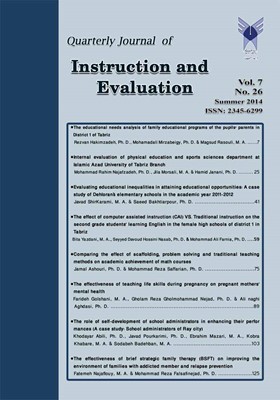Evaluating educational inequalities in attaining educational opportunities: A case study of Dehloran`s elementary schools in the academic year 2011-2012
Subject Areas : Educational Psychology
Javad ShirKarami
1
,
Saeed Bakhtiarpour
2
![]()
1 - دانشگاه آزاد اسلامی واحد دزفول، دانشآموخته کارشناسیارشد برنامهریزی آموزشی، دزفول، ایران. (نویسنده مسئول).
2 - استادیار دانشگاه آزاد اسلامی واحد اهواز، گروه روانشناسی، اهواز، ایران.
Keywords: : Educational Inequality, Education Needed Population, Education coverage, educational spaces, Elementary schools, Dehloran city,
Abstract :
In this study, the issue of educational inequalities is investigated in different educational areas through a case study at Dehloran`s elementary schools. The present study is a documentary study; the demographic data required for this study has been acquired by statistical data from the recent census of population and Housing as well as information regarding education (students, teachers and educational buildings) using the statistics provided by Dehloran education office. Then, the statistics were classified and adjusted in the researcher made information. To compare and rank the amount to which different areas and regions (rural or urban) benefit from elementary education, indicators and formulas for educational planning such as the index of region selection, Gini coefficient, Lorenz curve, and benefit levels chart were used. Moreover, in order to determine the educational inequalities, the data was analyzed using enrollment fees and the actual educational coverage, the ratio of students to teachers, utilization coefficient of educational spaces, and rates of the educational efficiency. The results of this study indicate that there is not a proper balance among different regions and areas (weather urban or rural) of Dehloran in terms of benefited educational opportunities. In terms of enrollment fees and educational coverage as well as access to elementary school teachers, urban areas as compared with rural areas and boys as compared with girls are at a higher level. Urban areas have more access to educational spaces compared to rural areas. As for the rates of educational efficiency, girls and urban areas are superior to boys and rural areas, respectively.
اسماعیلسرخ، جعفر (1386)، نابرابریهای آموزشی و نابرابریهای فضایی در بعد قومی و منطقهای (مطالعه موردی دوره ابتدایی استان آذربایجانغربی) در سال تحصیلی 81-1380، فصلنامه تعلیم و تربیت. سال 23، شماره 3.
تودارو، مایکل(1371)، توسعه اقتصادی درجهان سوم، ترجمه فرجادیپور. چاپ دوم، تهران: سازمان برنامه و بودجه.
توما، ژان (1370)، درون جهان سوم، ترجمه محمد نظری، تهران، انتشارات فاطمی.
داشخانه، فاطمه (1380)، بررسی عوامل مؤثر در نابرابریهای آموزشی در دوره آموزش عمومی به منظور ارائه مدلی نظری برای آموزش دختران، فصلنامه تعلیم و تربیت، سال 17، شماره 4.
دهقانی، سعیده (1384)، بررسی فرصتهای آموزشی در استان فارس در برنامه دوم و سوم توسعه، پایاننامه کارشناسیارشد، دانشگاه اصفهان، دانشکده علوم تربیتی و روانشناسی.
رفیعی، حمید (1378)، بررسی عوامل مؤثر در نابرابری فرصتهای آموزشی دورههای ابتدایی و راهنمایی مناطق آموزشی استان کرمان در سال تحصیلی 77- 76، دانشگاه علامه طباطبایی.
عبدوس، میترا (1381)، بررسی عوامل مؤثر در فرصتهای آموزش نابرابر بین دختران و پسران، خلاصه مقالات مهندسی اصلاحات در آموزش و پرورش، تهران: پژوهشکده تعلیم و تربیت.
عزیززاده، هادی (1367)، بررسی نابرابری دستیابی به فرصتهای آموزشی بین استانهای کشور در سال تحصیلی 66-1365، فصلنامه تعلیم و تربیت. شماره 3 و 4، ص 13 و 17.
کلیدری، محمدحسین(1374)، بررسی نابرابری فرصتهای آموزشی در استان خراسان طی سالهای برنامه اول توسعه 72-1368، پایاننامه کارشناسیارشد، تهران: دانشگاه علامه طباطبایی، دانشکده علوم تربیتی و روانشناسی.
گروه مشاوران یونسکو، (1384)، فرایند برنامهریزی آموزشی. ترجمه فریده مشایخ. چاپ شانزدهم، تهران: انتشارات مدرسه.
متوسلی، محمود؛ آهنچیان، محمدرضا (1390)،اقتصاد آموزش و پرورش، چاپ پنجم، انتشارات سمت.
مرادی، مسعود (1382)، بررسی فرصتهای آموزشی دوره متوسطه اول و عوامل مربوط با آن در مناطق آموزشی استان زنجان، شورای تحقیقات آموزش و پرورش استان زنجان.
مشایخ، فریده (1377)، فرایند برنامهریزی آموزشی. تألیف گروه مشاوران یونسکو، چاپ هفتم، تهران: انتشارات مدرسه.
معروفی، یحیی (1379)، بررسی نابرابری فرصتهای آموزشی دوره متوسطه در مناطق آموزشی تابعه استان کردستان در سنوات تحصیلی 72-71 الی 78-77، شورای تحقیقات اداره کل آموزش و پرورش استان کردستان.
ملکی، حسن (1372)، آشنایی با قانون اساسی، دوره کاردانی تربیت معلم، وزارت آموزش و پرورش.
موسوی، غلامرضا (1388)، بررسی میزان نابرابری فرصتهای آموزشی دورههای تحصیلی ابتدایی و راهنمایی استان ایلام در سال تحصیلی 87-1386، پایاننامه کارشناسیارشد، دانشگاه آزاد اسلامی واحد دزفول.
نبیزاده سرابندی، سیما (1384)، بیعدالتی در فرصتهای آموزشی استان سیستانوبلوچستان، مجله پژوهشهای زنان، دوره 3، شماره 3.
Garret, jeff. (2009). Separate and unequal A Structuralanglysis of education inequality in America, www.swirlinc.word press.com.
Hannum, Emily. (2000) .Educational, Expansion and Demographic, Harvard, Institute for International Development, www.census.org/ipc/.
Meyers, Rob. (2003).Inquality of Education, www.csue.berkcly.Edu/ Meyers/ Education term, Himl.
Rebell, and femininities in the primary classroom, M. A. (2003), Hearing: Americ`as school: providibg equal opportunity or sthllseparte and UN equal? New York.
Sheldon, G. w. (2000). The search for quality and equality, In A.R. welch(Ed), Third world education, Quality and equality.14.
Tomasevski, Katarina. (2005) .Education Denied costs and Remedies, March 2003.
UNESCO online, all Rights for all fiftieth Anniversary of the Universal Declaration of Human Rights.27.

